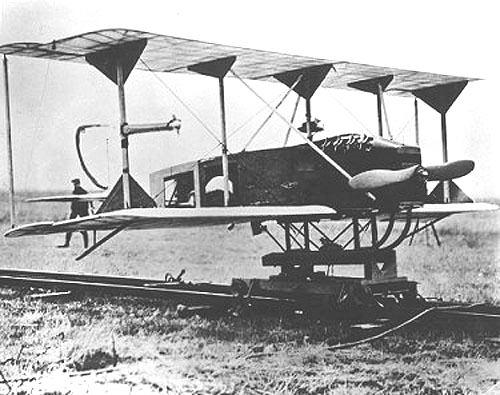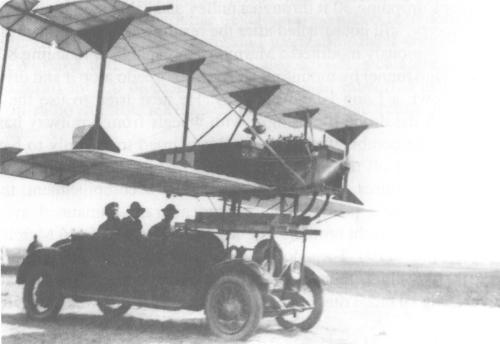Curtiss/Sperry "Flying Bomb"
The Curtiss/Sperry "Flying Bomb" was the first of two American efforts during the First World War to develop what would today be called a cruise missile. The other was the Dayton Wright Liberty Eagle, better known as the Kettering "Bug".
Between 1909 and 1914, Elmer Ambrose Sperry developed a gyrostabilizer, which could keep aeroplanes flying straight and level without pilot intervention. In 1915, Sperry was approached by the U.S. Navy to use his gyrostabilizer to build a pilotless aircraft to be used as a flying bomb. The device was frequently called an "aerial torpedo" at that time, but contemporary official Navy reports appear to prefer the name "Flying Bomb".
The "Flying Bomb" was to fly in a straight line to a preset distance (measured in flight by a "distance gear", which counted engine revolutions), and then automatically dive to the ground. The principle was first demonstrated successfully in September 1916 with a manned aircraft. An on-board pilot handled take-off and landing, but didn't touch the controls during the automatic portion of the flight. In May 1917, the Navy ordered five Curtiss N-9 seaplanes to be modified for systematic manned trials of the "Flying Bomb" technology. Flight tests began in September, and were generally successful. The accuracy was about 3.2 km (2 miles) after a distance of 50 km (30 miles). This was apparently regarded as good enough, because the Navy subsequently ordered six examples of a purpose-built "Flying Bomb" airframe from Curtiss. The device was to have a range of 80 km (50 miles) at 145 km/h (90 mph) with an explosive payload of 450 kg (1000 lb).
 |
| Photo: General Motors Institute |
| Curtiss/Sperry "Flying Bomb" |
The "Flying Bomb" (which had no other name or designation) was launched from a catapult, but on the initial three attempts in November/December 1917 the device failed to get airborne at all. On the next two flights in January 1918, the "Flying Bomb" crashed very shortly after take-off. To find out more about the stability problems at lift-off and in flight, Lawrence Sperry (Elmer's son) flew the aircraft twice in February (crashing on the second flight). As a result, several modifications were made, including lengthening the fuselage by 60 cm (2 ft). Further stability and control tests without risking to wreck the airframe were made by mounting it on top of a car and driving down a straight highway. Finally, on 6 March, an unmanned "Flying Bomb" flew successfully over the planned distance of 900 m (1000 yds). This was the first ever successful flight of a powered unmanned heavier-than-air craft in history.
 |
| Photo: via Newcome |
| Curtiss/Sperry "Flying Bomb" |
Unfortunately, this remained the only success for the "Flying Bomb", and by the end of September all "Flying Bomb" airframes had been expended in crashes. The last flights had used a new type of catapult, which had also uncovered further structural and stability deficiencies in the "Flying Bomb" airframe. Tests then continued with the N-9 aircraft, and in October one of these possibly set a distance record when the distance mechanism (set at 12800 m (14000 yds)) failed and the aircraft flew on over the sea and disappeared.
After the war had ended, the Navy nevertheless decided to continue the flying bomb experiments, and ordered five examples of a new airframe design from Witteman-Lewis. It first flew in March 1919. However, tests with this aircraft, and another flying bomb built by the Naval Aircraft Factory, were not really successful, and the whole program was terminated in 1922. The U.S. Navy did not re-enter the field of unmanned aircraft in earnest until the mid-1930s, when several manned aircraft of different types were converted to radio-controlled drones. These experiments eventually lead to the TDR and TDN "assault drones" of World War II.
Specifications
Note: Data given by several sources show slight variations. Figures given below may therefore be inaccurate!
Data for Curtiss/Sperry "Flying Bomb":
| Length | 4.6 m (15 ft) |
| Wingspan | 7.6 m (25 ft) |
| Weight | 680 kg (1500 lb) |
| Speed | 145 km/h (90 mph) |
| Range | 80 km (50 miles) |
| Propulsion | Curtiss OX-5 piston engine; 74 kW (100 hp) |
| Payload | 450 kg (1000 lb) high-explosive |
Main Sources
[1] Kenneth P.Werrell: "The Evolution of the Cruise Missile", Air University Press, 1985
[2] Laurence R. Newcome: "Unmanned Aviation: A Brief History of Unmanned Aerial Vehicles", AIAA, 2004
Back to Directory of U.S. Military Rockets and Missiles, Appendix 4
Last Updated: 12 May 2005